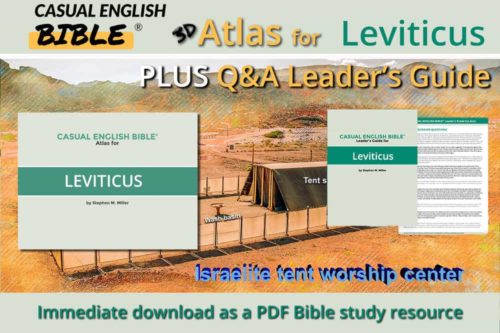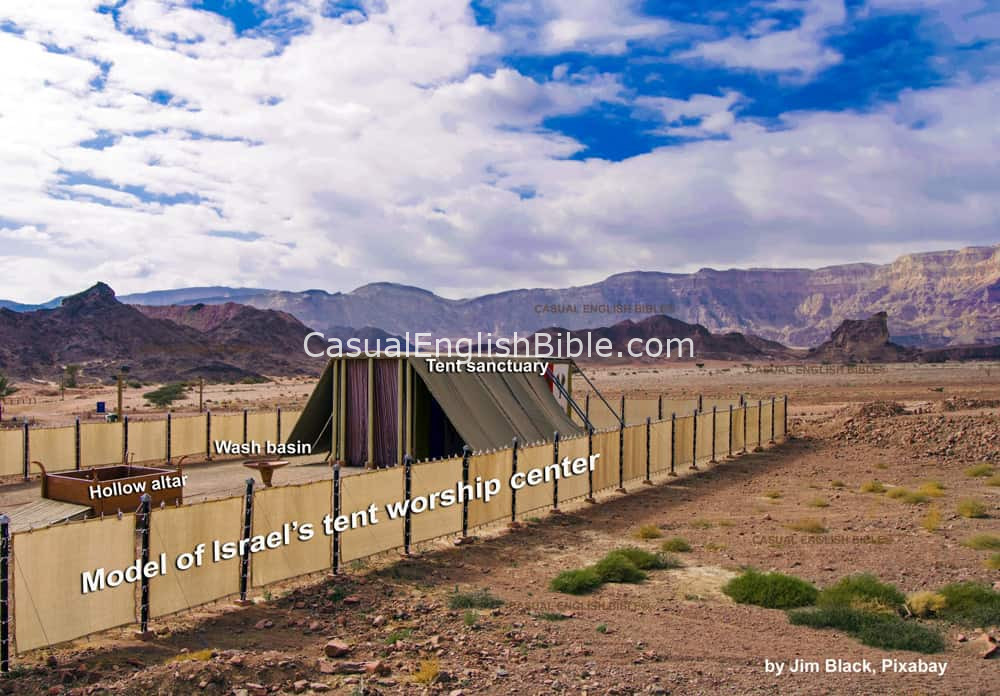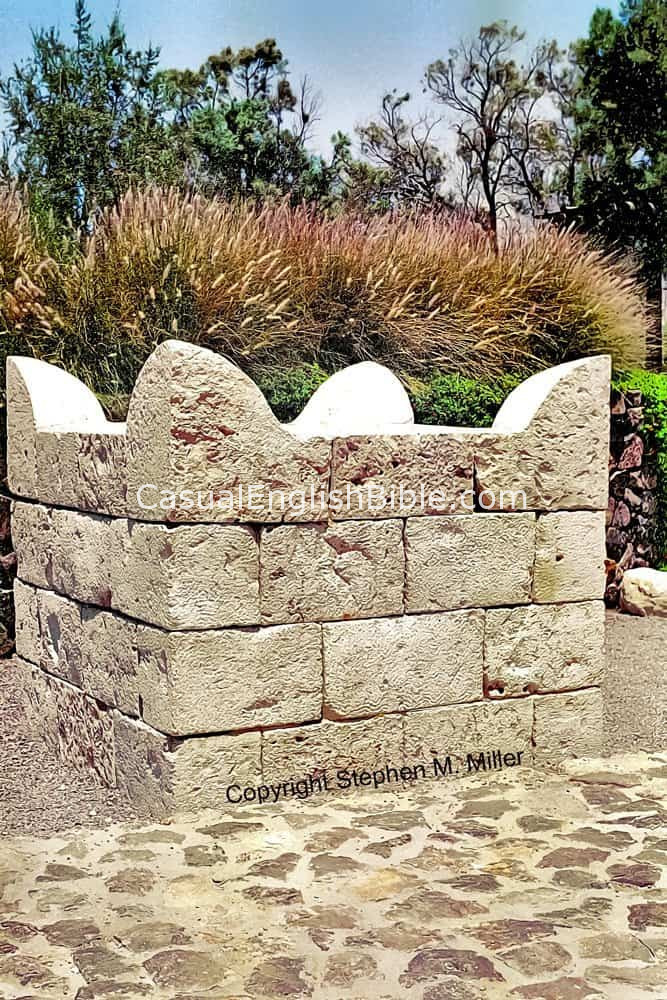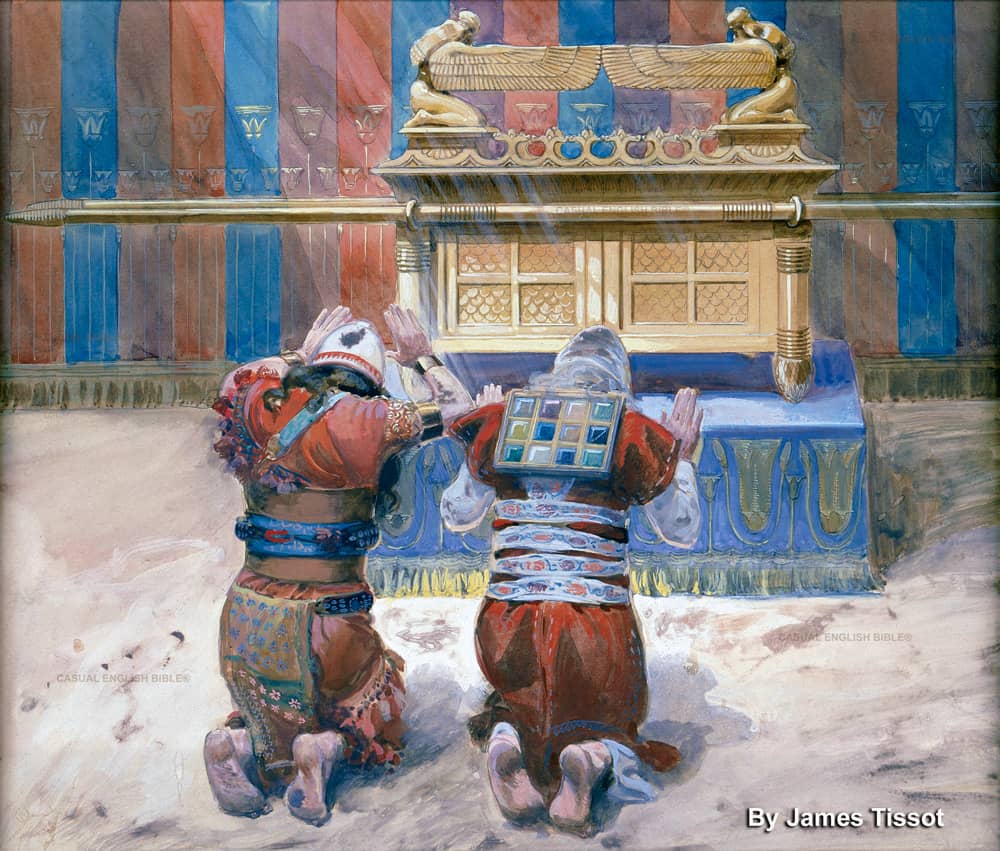Leviticus 16
Yom Kippur: Day to come clean
Aaron’s Day of Atonement to-do list
1The LORD spoke to Moses after Aaron’s two sons died. The two died together, as they approached the LORD one day. [1] 2The LORD told Moses:Tell your brother Aaron that he doesn’t get to decide when it’s okay to go into the worship center’s Most Sacred Room. [2] If he ignores this warning, he’ll die. The sacred chest [3] containing the Ten Commandments isn’t the only thing in that room, on the other side of the curtain. I’m there, too, in a cloud rising above the lid on top of that chest.
3Before Aaron does go into the Most Sacred Room, here’s what he needs to do. He needs to sacrifice a young bull as a sin offering [4] and a male goat as a burnt offering. [5] 4Also, he needs to take a bath and then put on sacred linen clothes of an ordinary priest: linen underwear, a linen tunic shirt with a linen sash belt, and a linen turban for his head. [6]
5For the people of Israel, Aaron should sacrifice two male goats as a sin offering and one ram as a burnt offering. 6The bull he’s to kill as a sin offering is for himself. It will atone for his sins and for those of his family. It will restore all of them to good standing with the LORD. 7As for the two goats he’ll offer on behalf of Israel, he should take them to the place where he makes other sacrifices, near the entrance into the tent sanctuary.
Pick a scapegoat
8Aaron should randomly choose [7] which goat to offer to the LORD and which to release as the scapegoat, [8] sent into the badlands to carry away Israel’s sins.9Aaron should sacrifice the goat chosen for the LORD. 10He should present the scapegoat to the LORD, without killing it. This act will atone for the sins of the people and will put them on good terms with the LORD. Then Aaron should send the goat on its way, into the badlands.
11After that, Aaron should sacrifice the bull as a sin offering to atone for his sins and for the sins within his family. This will put his family on good terms with the LORD.
Fire in the tent worship center
12Then Aaron should go to the altar and shovel a few hot coals into a firepan. He should carry this firepan into the Most Sacred Room, with two handfuls of fragrant incense, ground into a fine powder. 13Aaron should sprinkle the incense onto the fire. He should do this until a cloud of incense covers the sacred box holding the Ten Commandments. If he doesn’t follow these instructions, he’ll die.14He should also take some blood of the bull. With a finger, he should sprinkle the blood onto the east side of box’s lid. [9] He should also sprinkle some in front of the lid, seven times. 15Then Aaron should go outside and sacrifice the people’s goat as a sin offering. What he did earlier with the bull’s blood is exactly what he should then do with the goat’s blood. He should sprinkle it on and in front of the box’s lid.
16This is how he’ll clean the Most Sacred Room, sweeping out the contamination of Israel’s sins. He’ll do the same for the tent worship center, purifying it, too. 17When he goes into the tent’s sanctuary, the Sacred Room, [10] he needs go alone. No one else should go in until he comes back out, after he performs the rituals that atone for the sins of his family and for the rest of Israel.
18When Aaron comes out, he needs to cleanse the altar. He’ll do this by wiping some blood of the bull and goats onto the horns [11] of the altar. 19He should sprinkle the rest of the blood over the altar, and do it seven times. This will clean away the sins that Israel brought to the altar, and make it holy again. 20Once Aaron finishes cleansing the Sacred Room, the altar, and the tent worship center, he should turn his attention to the goat that’s still alive.
Releasing the scapegoat
21Aaron should put his hands on the goat and start confessing the sins of Israel, one sin at a time. By doing this, Aaron transfers Israel’s guilt to the goat. Someone chosen ahead of time should then lead the goat out of the camp and into the badlands. 22As the goat wanders into a desolate land, it takes with it all of Israel’s sins. 23When this is done, Aaron should go back into the tent sanctuary, take off his clothes, and leave them there.24He should bathe in a sacred place and put on his jewel-studded high priestly clothes. Then he should come back outside and sacrifice his personal burnt offering followed by a second burnt offering for the people. This will atone for their sins and put them on good terms with the LORD. 25He should burn all the fat of both animals, sending it up in smoke as an offering from the altar.
26The man who led the scapegoat into the badlands has to bathe in water and wash his clothes before coming back into the camp. 27What’s left of the bull and the goat, killed as sin offerings to cleanse the Sacred Room, should be carried outside the camp and burned. Their hides, internal organs, and intestines should be destroyed in the fire. 28The man who does this chore needs to wash his clothes and take a bath before coming back into the camp.
29Everything I’ve just told you to do is permanent. Do it every year at this time, on the tenth day of this seventh month of the year. [12] Spend the day fasting. [13] Don’t do any work. Native-born Israelite or immigrant living among—it doesn’t matter. Neither is allowed to work. 30This is the day of your atonement—when your sins are carried away. You’re not guilty anymore. You’re on good terms with the LORD. 31Treat this day like the Sabbath, as a day of fasting and reflection. Do this every year for the generations to come.
32In the future, whoever is designated to follow in Aaron’s footsteps as high priest will do as I’ve just instructed Aaron to do. The future priest will begin by dressing up in the linen clothes reserved for the high priest. 33He will purify the tent worship center and the altar. He will atone for the sins of all the priests and the rest of Israel, putting them all on good terms with the LORD. 34Do this every year on this day, to atone for the sins of Israel—to put the people on good terms with the LORD.
Moses delivered this message, just as the LORD told him to do.
Footnotes
That’s a kind way to put it. The initial report suggests they came to the LORD in an inappropriate way. See Leviticus 10:1-5.
The largest and main part of the space inside the tent sanctuary was the Sacred Room. Aaron’s sons were allowed to go in this room. But the Most Sacred Room was off limits to everyone but Aaron and Moses. That’s where God met with Moses to give him instructions. This holiest place on earth to Israelite ancestors of the Jewish people is where they kept the gold-plated box that held the two stones containing the Ten Commandments. The box is best known as the Ark of the Covenant. A curtain separated this room from the main room in the tent worship center sometimes known as the Tabernacle and sometimes as the Meeting Tent.
More often called the Ark of the Covenant. It was a wooden chest plated with gold all over. Inside that chest was a golden jar with some manna, Aaron’s almond wood staff that budded, and stone tablets engraved with the Ten Commandments. Covering the chest was a lid with figures representing glorious celestial beings called cherubim. This was the place where God’s people found forgiveness (Exodus 25:10-22; Hebrews 9:4-5). It became Israel’s most sacred object. They taught that the lid of the box was God’s “footstool,” (1 Chronicles 28:2, English Standard Version).
A sin offering can refer to something the people of Israel brought to God after they realized they had accidentally broken one of God’s laws earlier. Some scholars say a better translation is the opposite of “sin” because the sacrifice is intended to “un-sin” people, to purify them. So those scholars call it a “purification offering.”
This was the most common sacrifice. Worshipers burned the entire animal. Burnt offering instructions: “Take the animal to the north side of the altar. Kill it there on this sacred site of the LORD. Aaron’s sons, the priests, will take some of the blood and splash it on all four sides of the altar. Cut the animal into pieces, including the head and the fat. A priest will set them onto the fire on the altar” (Leviticus 1:11-12). See also Leviticus 1:3-13; 6:1-6.
For a more complete description of the high priest’s clothing, see Leviticus 8:7-9.
More literally, “throw lots.” The “lots” may have been stones or dice-like objects they used to get a yes or no answer from God, since they believed God controlled everything that happened.
More literally, the second goat was designated “for Azazel.” Early Jewish scholars broke this word in two: ez ‘azel, “goat leaves,” which is where the term “scapegoat” came from. When Jewish scholars, a century or so before Jesus’ birth, translated this passage into Greek, the international language of the day, they translated this phrase as the goat “carrying away.” By implication, since Aaron was offering sacrifices for sins, the goat was carrying away the nation’s sins. Some scholars referred to Azazel as an otherworldly being opposite of God. So, the goat was designated to go to this evil being, while taking Israel’s evil with it.
Israelites taught that the lid of the box was God’s “footstool,” (1 Chronicles 28:2, English Standard Version).
Normally, all priests are allowed in this room, the largest of the two in the tent. But on this occasion, only Aaron and his successors as high priest can go inside.
Archaeologists have uncovered many “horned altars” in Israel and Palestinian Territories. Bible writers never explained why altars were built with the corners turned up like animal horns. Perhaps the horns were a tribute to the livestock sacrificed on the altar. One more common guess is that the horns gave priests something to which they could tie the dead animal. This could help keep the sacrificed animal from rolling off the fire before it was burned. Psalm 118:27 seems to add credibility to that theory: “Go ahead and tie the festival sacrifice to the four corners of the altar.” Consider how it might feel for a worshiper to watch the sacrificed animal roll off the flaming altar before the animal had even caught fire. We might understand that the animal fell off because the burning wood pile shifted as wood disintegrated in the fire. But someone offering a sacrifice to seek forgiveness for sin might think God had just rejected the offering.
Jewish people today call it Yom Kippur. In Bible times it was known as the Day of Atonement. Israelites followed a lunar calendar, with every month starting at the first tiny crescent after the new moon. A new moon is when the moon is hidden behind earth’s shadow for one day. The sun, moon, and earth are aligned, with earth in the middle. The seventh month usually occurred in September or October.
The term is more literally, “deprive your throats,” as in, “don’t eat or drink.” The practice is often called “self-denial.” Instead of eating, people are encouraged to pray and to confess the sins they’ve committed over the past year.
Discussion Questions
- 1
BY ROBERT V. HUBER
This chapter, which focuses on the establishment of the Day of Atonement, opens with a reference to the deaths of Aaron’s sons for wrongly offering incense in the tent worship center. Why do you think the author mentions that incident at this point?
- 2
It seems odd that God announces this new holy day to Moses and not Aaron, the high priest who would be the first to officiate at its rites. Why do you think he did so?
- 3
In verse 4 Aaron is told he must dress in the linen clothes of an ordinary priest and not in his gold-embroidered high-priestly vestments. Why this apparent demotion of Aaron for this ritual?
- 4
God tells Moses that before cleansing the people Aaron must cleanse the entire tent of worship on the Day of Atonement. He was to begin by entering respectfully beyond the veil and filling the Most Holy Place with incense that obscured the sight of the Ark of the Covenant that contained the tablets of the Ten Commandments. Why all that incense?
- 5
After offering sacrifices to atone for his own sins and the sins of the people, Aaron places his hands on a goat he has set aside, symbolically loading the sins of the people on the animal, then sends that animal out into the badlands to carry away those sins. God insisted that these rites be performed every year. Jews still celebrate this day as Yom Kippur. What do you know about the story behind how the celebration moved from animal sacrifice to how Jews celebrate it today—and why Christians stopped celebrating it at all?
- 6
LIFE APPLICATION. With no Day of Atonement, Christians look for other means of asking God to forgive their sins. While many Christians say they believe that Baptism takes away their sins, they must look for ways to be absolved for sins committed after Baptism. Some churches have a separate rite of reconciliation (Confession). How do you think other Christians seek God’s forgiveness for the sins they commit?









